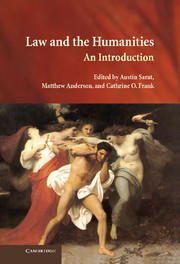Book contents
- Frontmatter
- Contents
- Contributors
- Acknowledgments
- Introduction: On the Origins and Prospects of the Humanistic Study of Law
- I PERSPECTIVES ON THE HISTORY AND SIGNIFICANCE OF SCHOLARSHIP IN LAW AND THE HUMANITIES: THREE VIEWS
- II IDEAS OF JUSTICE
- III IMAGINING THE LAW
- 8 Imagining the Law: The Novel
- 9 Imagining Law as Film (Representation without Reference?)
- 10 Law and Television: Screen Phenomena and Captive Audiences
- 11 Imagining the Law: Art
- IV LINGUISTIC, LITERARY, AND CULTURAL PROCESSES IN LAW
- V INSTITUTIONAL PROCESSES
- Index
- References
11 - Imagining the Law: Art
Published online by Cambridge University Press: 20 January 2010
- Frontmatter
- Contents
- Contributors
- Acknowledgments
- Introduction: On the Origins and Prospects of the Humanistic Study of Law
- I PERSPECTIVES ON THE HISTORY AND SIGNIFICANCE OF SCHOLARSHIP IN LAW AND THE HUMANITIES: THREE VIEWS
- II IDEAS OF JUSTICE
- III IMAGINING THE LAW
- 8 Imagining the Law: The Novel
- 9 Imagining Law as Film (Representation without Reference?)
- 10 Law and Television: Screen Phenomena and Captive Audiences
- 11 Imagining the Law: Art
- IV LINGUISTIC, LITERARY, AND CULTURAL PROCESSES IN LAW
- V INSTITUTIONAL PROCESSES
- Index
- References
Summary
Street photographer Philip-Lorca diCorcia took candid images of passers on the streets of New York City without their knowledge. From twenty feet away, he operated a system of strobe lights and a camera attached to construction scaffolding aimed toward a fixed point on the sidewalk. Eighty-four-year-old Erno Nussenzweig, a retired diamond merchant from New Jersey, was one such passerby who had his image captured. DiCorcia selected Nussenzweig's image, along with sixteen others of the numerous photographs taken over a two-year period, edited them and blew them up into 48- by 60-inch posters, which he sold for between $20,000 and $30,000 each. Nussenzweig, as an Orthodox Hasidic Jew and member of the Klausenberg Sect – which was nearly eliminated during the Holocaust – possessed a deeply held religious conviction that diCorcia's use of his image violated the second commandment's prohibition against graven images. Nussenzweig sued diCorcia for invasion of privacy.
In dismissing the suit in 2006, a New York court determined the photograph in question to be “art,” and thus immune from such challenges. In so concluding, however, the case prompts further inquiries. How was the court able to make this determination when so many art experts are confounded by the question of what is art? What guidance, if any, does the law offer in making these determinations? Should these determinations be made by law? Has the law adopted an aesthetic theory? How does law appreciate the creative acts of the photographer?
- Type
- Chapter
- Information
- Law and the HumanitiesAn Introduction, pp. 292 - 312Publisher: Cambridge University PressPrint publication year: 2009



